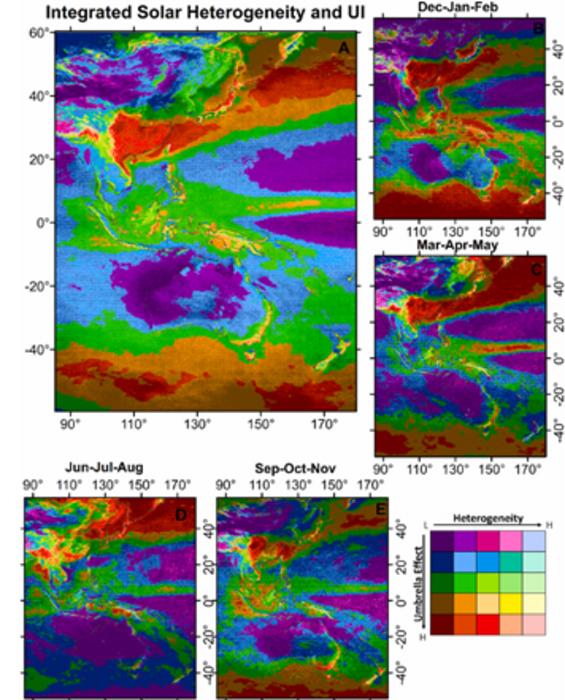Amidst the ongoing energy crisis and under the threat of climate change, exploiting renewable energy sources has quickly become a global necessity. Though our options are varied, solar energy seems to be our best bet—experts estimate that it may become our main energy source well before the turn of the century.

Credit: Kalingga Titon Nur Ihsan from Chiba University and Institut Teknologi Bandung
Amidst the ongoing energy crisis and under the threat of climate change, exploiting renewable energy sources has quickly become a global necessity. Though our options are varied, solar energy seems to be our best bet—experts estimate that it may become our main energy source well before the turn of the century.
Despite its clear advantages, solar energy generation has some limitations. Much like the wind, solar irradiance in a given region can vary quickly depending on weather conditions, causing fluctuations in power output. These fluctuations not only pose a problem for power grids but also imply that meeting energy demands may not always be a guarantee. Thus, having a clear understanding of the possible variations in solar irradiance in time and space is crucial to determining the optimal locations for solar power plants.
Against this backdrop, a research team led by Specially Appointed Assistant Professor Hideaki Takenaka from the Center for Environmental Remote Sensing, Chiba University, set out to extend our knowledge of solar irradiance over the Asia Pacific region. In their latest study, made available online on June 13, 2024, and published in Volume 276 of Solar Energy in July 2024, they conducted an in-depth analysis of solar irradiance data gathered from geostationary satellites. Other team members included Kalingga Titon Nur Ihsan, Graduate School of Science and Engineering, and Atsushi Higuchi, Center for Environmental Remote Sensing, both from Chiba University, as well as Anjar Dimara Sakti and Ketut Wikantika from the Center for Remote Sensing at Institut Teknologi Bandung.
The data for the analysis came from Himawari-8 and Himawari-9, two Japanese satellites that collect images with high temporal and spatial resolution over the Asia Pacific region. The researchers used AMATERASS solar radiation data obtained from quasi-real time analysis of solar radiation synchronized with geostationary satellite observation. They were developed by Dr. Takenaka and colleagues to accurately estimate solar irradiance via high-speed radiative transfer calculations using neural networks. AMATERASS operation started in July 2007, and analysis data was archived continuously for over 16 years. This data was made publicly available by the Chiba University, CEReS DAAC (Distributed Active Archive Center), downloaded 186,465,724 times, and used in various research and Japanese national projects. By leveraging this technology, the team estimated solar irradiance variability in terms of spatial and temporal heterogeneity. Simply put, they calculated how drastically solar radiation varies in space and time by analyzing solar irradiance data over a 20 km by 20 km grid every ten minutes.
Their analysis revealed interesting facts about solar irradiance over the region. For example, the team found that locations near the equator experienced lower fluctuations in solar irradiance over time compared to higher latitude regions due to the effects of rain and cloud activity. Moreover, regions of higher elevation exhibited higher heterogeneity due to higher cloud activity. The area around the Tibetan Plateau showed high seasonal changes in the magnitude of the ‘umbrella effect,’ which quantifies how much solar energy is reflected back to space. “Our evaluations based on spatiotemporal data revealed characteristics that would’ve been impossible to achieve using a traditional approach that relies on simple long-term averages or TMY (Typical Meteorological Year) as a typical solar irradiance data,” highlights Dr. Takenaka.
In addition to these insights, the research team assessed the performance of over 1,900 existing solar power plants using annual and seasonal data. They found that, due to umbrella effects caused by clouds, the production of a large portion of these plants is not optimum from June to August. This implies that the most affected zones should not rely entirely on solar power to meet increased demands during these months.
Finally, the researchers also investigated the optimal format for future solar power plants, concluding that more widely distributed solar energy generation is superior to more localized efforts. “Based on the spatial and temporal characteristics of solar irradiance, we suggest that it should be possible to suppress rapid fluctuations in solar power generation output by distributing small photovoltaic systems over a wide area rather than relying on large solar power plants,” explains Dr. Takenaka. “Worth noting, these conclusions come from weather and climate research, not an engineering perspective.” One way to achieve this vision might be through the use of rooftop solar panels, which is a growing trend in many countries.
Overall, the findings of this study will help us plan for the short- and long-term future of solar energy generation in the Asia Pacific region, bolstering sustainable energy technologies and aiding in our fight against climate change.
About Specially Appointed Assistant Professor Hideaki Takenaka
Hideaki Takenaka obtained a Ph.D. degree from Chiba University in 2009. He currently holds a special research and teaching position at the Center for Environmental Remote Sensing at Chiba University. His work focuses on solar energy, satellite remote sensing, solar radiation monitoring, and weather and climate science. He has published over 40 papers on these topics.
Journal
Solar Energy
Method of Research
Data/statistical analysis
Subject of Research
Not applicable
Article Title
Solar irradiance variability around Asia Pacific: Spatial and temporal perspective for active use of solar energy
Article Publication Date
1-Jul-2024
COI Statement
The authors declare that they have no known competing financial interests or personal relationships that could have appeared to influence the work reported in this paper.



